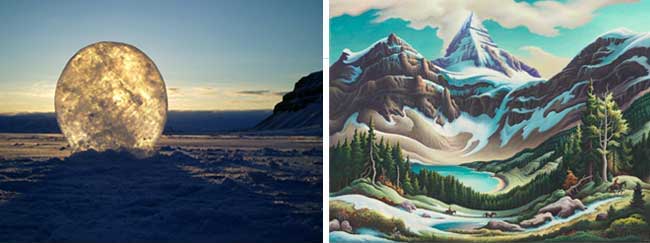
By the breath of God ice is given,
and the broad waters are frozen fast.
11 He loads the thick cloud with moisture;
the clouds scatter his lightning.
We went to the McMichael Gallery in Kleinburg on Saturday for the Vanishing Ice exhibit which includes paintings, photos, videos and more. The exhibit sprawls through many rooms of the gallery and extends outside, offering a varied outlook on the ice which is a significant portion of our planet and yet is changing rapidly due to climate change. This is an excerpt from the description of the exhibit:
During the eighteenth and nineteenth centuries, a passion for alpine landscapes spread throughout Europe and later into North America. Artists, scientists, and writers introduced the sublime beauty and natural history of these regions, which were once fearfully regarded as the home of demons and dragons. Artists’ depictions of alpine landscapes helped popularize the revolutionary idea of an Ice Age governed by the movement of glaciers and ice sheets over vast stretches of time. Their work contributed to an expanded vision of the planet’s age and dynamics of formation.
Artworks appeared in scientific publications, travelogues, popular magazines, and exhibitions. A vogue for mountain climbing and tourism to alpine terrain rapidly developed.The integration of the arts and sciences stimulated a closer connection to the natural world. This led to the foundation of organizations such as the Sierra Club (1892) and the movement for environmental preservation. Artists were commissioned to create mural-size landscape paintings for natural history museums and schools of higher learning. These works helped students and visitors visualize the movement of glaciers, which was key to understanding the process of ice age formation and retreat.
Canada celebrates its abundance of fresh water but much of that is in the form of retreating ice and melting permafrost. We really don't know what will happen to the planet if it all melts, but it won't be positive from scientific or aesthetic points of view.
Christians don't have a theology of ice, but we do affirm that water is a gift from God and living water is a powerful metaphor of faith. Surely that extends to all forms of water?
We enjoyed the exhibit but we wished there were more original paintings, including some of the work of David Blackwood.And the spiritual/religious aspects could have been explored further. But I quibble. Make sure you catch the exhibit before it melts April 26th. http://www.mcmichael.com/vanishingice/
It was serendipitous or providential that Inuit environmental activist Sheila Watt-Cloutier has been talking about her new book The Right to Be Cold on CBC and elsewhere during the past week. We may be more than willing to relinquish that right to be cold, but those who live in the North are aware of the effects of climate change on their way of life.
Have you seen the exhibit or heard Watt-Cloutier? Are they of interest?

Cool Facts About Ice
● “Ice is a common material with uncommon properties: it can flow downhill like a river, carve rock like a chisel, reflect sunlight like a mirror, and float on water like a cork.” — Henry Pollack, geophysicist and author of A World Without Ice, 2009
● Ice contains 75% of the world’s fresh water.
● Ice can reveal the planet’s climate history dating back 800,000 years.
●90 percent of a floating iceberg is actually beneath the water, which led to the expression, “That’s just the tip of the iceberg.”
2 comments:
The other interesting thing is that H2O is the only substance I'm aware of that expands when migrating from the liquid state (water) to the solid state (ice). Maybe there's some kind of a metaphor here.
The other thing I've read about is that while some projections show 2deg. climate warming in lower latitudes, the polar regions could experience triple that amount. Obviously, the right to be cold will be adversely impacted.
I've heard and seen similar stats Frank. Ironically the effect on the jet stream may be the reason we have experienced such cold winters in this neck of the woods when the planet as a whole is heating up.
Post a Comment